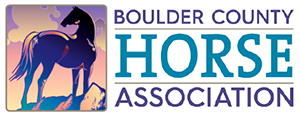Information sourced from an article published by Steve Fransen and Ned Zaugg, Washington State University
The recent flooding in Boulder County requires close monitoring of stored hay for signs of spontaneous combustion. Dry hay (stored at 15 percent moisture or less) is safe for long-term storage. However, if the hay has become wet the quality has been permanently changed and there is an increased potential of a fire hazard from spontaneous combustion.
As microbial organisms grow in wet hay they produce heat while drying out the surrounding surfaces of the hay for energy. More drying surfaces produces more microbial growth and different types of microbes live and die as the internal bale temperature climbs. When the bale temperature reaches about 150 Fº the hay is on a one-way street and going the wrong direction! The larger the haystack and the more densely packed the hay is the longer it may take to show signs of internal bale burning. Internal bale temperature may take several weeks before reaching 150 Fº, but from this point on more heat resistant bacteria start a process of chemical change that rapidly increases temperatures to the point of spontaneous combustion.Chemical reactions and microbial growth in hay occur because of the change in availability of moisture, oxygen, and pressure to create heat to the point of ignition and fire. Early warning signs are:
- Steam rising from bale surfaces and condensing on the roof and eves of the barn. Often molds will start to grow on all these surfaces too.
- An acrid, hot, tobacco smell rising from the bales. Even before these visual signs appear, it is wise to take the temperature of the bales in the stack.
If the hay is in round bales, probe the bale ends. If in square bales, probe from the sides. If you do not have a long temperature probe, you can use a crowbar. If the haystack is large, push the crowbar in between bales as deep as you can go. Leave the crowbar there for about two hours. Remove the bar and feel with your bare hands. If the crowbar is easily handled, without feeling heat or discomfort, the hay in that area has not heated yet. If the crowbar can only be held for a short time, the hay temperature is approaching 130 Fº. If the bar can only be touched briefly, hay temperatures are about 140 Fº. At 150 Fº, the bar is too hot to hold.
What You Can or Must Do to Prevent Combustion
- When bale temperature rises to 150 – 160 Fº, take action, fire is likely from 180 to 212 Fº. Do not walk on the top of a heating haystack it could collapse. Call your local fire department and remove all animals and equipment away from the barn.
- Prepare a place for storing good hay and a place for hot or burning hay. After the fire department has arrived carefully start removing the bales from the barn — the new infusion of air into the stack may be just the fuel needed for the entire structure to go up in flames.
- Store bales individually to allow for maximum airflow and enhance heat loss from the bales. Large, one-ton bales will likely not dry in the center even after stored individually. These large bales will need to be broken apart for more complete drying. Small square bales stacked loosely may dry without splitting, but continue monitoring temperatures until they stabilize at less than 110 Fº.
If you see any flames appear in the stack or the bale as wet bales are removed, douse it well with water to cool and extinguish the fire. If certain materials have been applied to the hay, such as ethoxyquin and BHT (butylated hydroxytoluene), a deadly gas, hydrogen cyanide, will be produced during the burning process.
Hay Quality: some potential problems
A secondary problem with the wet hay is the nutritional value has been reduced from its initial quality. Heated hay may have a large amount of the protein now bound to the fiber and thus unavailable to livestock. Also, unknown pollutants may have contaminated the hay, so toxins could be produced from other microorganisms now living on the hay or toxic substances may have contaminated the hay. It may be best to not use it for feed.
We hope you find this information helpful.
BCHA
DISCLAIMER
The materials and opinions contained in the Boulder County Horse Association (BCHA) “Nicker” are being made available to followers of this blog as a service to equestrians for informational purposes only.
Neither BCHA, the Board of Directors, members, or anyone else who submits material for this blog, assume any legal liability or responsibility for the accuracy, completeness, or usefulness of any opinion, information, product or process disclosed herein. Unless otherwise specifically stated, reference to any position or opinion, or commercial product, process, service, manufacturer, or otherwise, does not constitute or imply its endorsement or recommendation by the Boulder County Horse Association, its officers, directors, or members, or any agency or entities affiliated with the organization.
